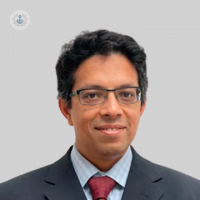Bronchoscopy: An expert insight into the procedure
Autore:A bronchoscopy is a medical procedure performed by a respiratory physician to examine the inside of the airways and the lungs using a tube called a bronchoscope. Depending on the purpose of the bronchoscopy, samples may also be taken during the procedure for diagnosis.
Here to provide an expert insight into a bronchoscopy procedure, including indications, risks and benefits, is Dr Bhashkar Mukherjee, leading consultant physician in respiratory and internal medicine.

What are the indications for a bronchoscopy?
A bronchoscopy may be performed:
- To diagnose lung conditions: For example lung cancer, chronic or recurrent lung infections (tuberculosis or fungal infections), or interstitial lung diseases (pulmonary fibrosis).
- To evaluate symptoms: For example chronic coughing, haemoptysis, wheezing, or pulmonary bleeding.
- To assess airway abnormalities: For example recurrent infections, airway inflammation, airway obstructions (narrowing or blockage), tumours, foreign bodies, or airway strictures.
- To remove foreign bodies from the lungs.
- To treat and intervene: For example, for stent placement in narrowed or blocked airways, for laser therapy for the removal of tumours or lesions, or for bronchial thermoplasty for severe asthma.
- To evaluate unexplained chest x-ray or chest CT scan abnormalities.
How is a bronchoscopy performed? How are samples taken during the procedure?
Before the bronchoscopy, the patient will be asked to avoid eating and drinking for a few hours to ensure an empty stomach. Local anaesthetic will then be applied to the back of the throat or sprayed into the nose and throat to numb the area and reduce discomfort during the procedure. Commonly, a low dose of sedation is given intravenously to improve airways tolerability, but this remains usually an awake procedure. In some cases, IV lines may be inserted to provide fluids.
The patient will generally be positioned in a semi-reclined or lying-down position for the insertion of the bronchoscope, which is a thin flexible tube with a light and a camera at its tip which may also have channels for medical instruments to pass through. The bronchoscope will allow the specialist to visualise the airways, including the trachea, bronchi and smaller air passages, and the camera will provide real-time images on a monitor, allowing the specialist to examine the airways and identify any abnormalities. The bronchoscope will be inserted through the mouth or nose and passed down the throat into the airways, while the patient breathes slowly and deeply.
When it comes to samples, there are several ways to collect them depending on the purpose of the procedure. These include:
- Bronchial wash: A small amount of sterile saline is introduced through the bronchoscope into a specific area of the lung. The saline is then suctioned back along with cells and secretions for analysis.
- Bronchial brushing: A small brush is passed through the bronchoscope and used to gently collect cell samples from the airway lining.
- Biopsy: In some cases, small tissue samples (biopsies) may be taken from abnormal-looking areas using specialised instruments such a biopsy-forceps that are passed through the bronchoscope.
- Trans-bronchial needle aspiration: For sampling lymph nodes or masses near the airways, a thin needle is passed through the bronchoscope to obtain tissue or fluid samples.
The samples collected will later be sent to a laboratory for analysis, which may include cytology, histology, or microbiology testing.
Once the examination and sample collection are complete, the bronchoscope will slowly be withdrawn. The patient will be monitored in a recovery area until the effects of the anaesthesia wear off.
Are there any potential risks and complications associated with a bronchoscopy?
A bronchoscopy is generally considered safe, but like with any medical procedure, there are certain risks and potential complications involved. These include bleeding, infection, pneumothorax, allergic reactions, or anaesthesia complications.
In some cases, it may also be difficult to obtain sufficient or high-quality samples during the procedure, which may require a repeat bronchoscopy or alternative diagnostic methods.
What are the benefits of a bronchoscopy compared to other diagnostic options?
A bronchoscopy offers several advantages compared to other diagnostic options when evaluating and treating various lung and airway conditions. These include:
- Direct visualisation: A bronchoscopy provides a direct and real-time view of the airways and lungs, allowing the specialist to visually assess the condition and even perform interventions during the same procedure.
- Sample collection: A bronchoscopy enables the collection of biopsies, secretions, or fluid from within the lungs, including deep samples which are difficult to obtain by other means. These samples are essential for the diagnosis of lung diseases, infections, and cancers.
- Targeted biopsy: A bronchoscopy can precisely target specific areas of concern, such as suspicious lesions or nodules, which reduces the need for more invasive procedures.
- Treatment and intervention: In addition to diagnosis, a bronchoscopy allows for therapeutic interventions, such as removing foreign bodies, clearing airway obstructions, placing stents, and treating conditions like lung cancer or airway strictures.
- Minimally invasive: A bronchoscopy is generally less invasive than surgical procedures. It can often be performed on an outpatient basis, resulting in a shorter recovery period.
- Customised approach: The bronchoscope can be guided to specific areas of concern, which is particularly valuable when investigating localised lung diseases or focal abnormalities.
While a bronchoscopy offers numerous benefits, it is important to know that it may not always be the most suitable diagnostic option. Other diagnostic options, such as chest imaging (X-rays, CT scans), pulmonary function tests, or blood tests may also play a role in the diagnostic process, often in conjunction with a bronchoscopy or simply as initial screening tools.
Dr Bhashkar Mukherjee is a leading consultant physician in respiratory and internal medicine with over 20 years’ experience.
If you require expert diagnosis and treatment for a lung and/or airway condition, don’t hesitate to book an appointment with Dr Mukherjee via his Top Doctors profile today.


